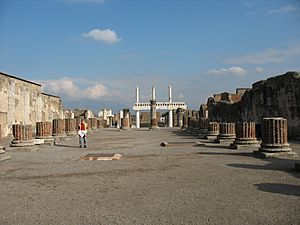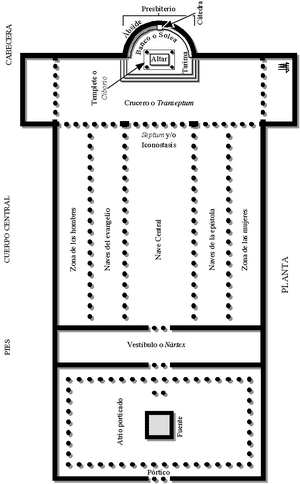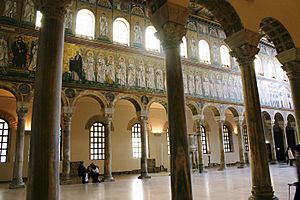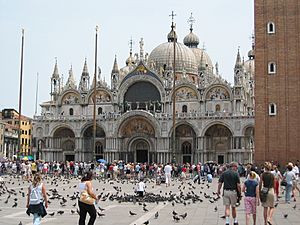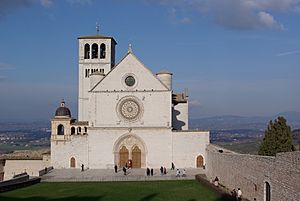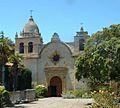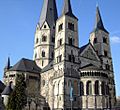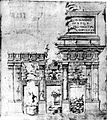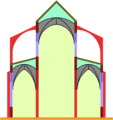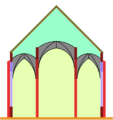Basilica facts for kids
A basilica is a very important church. The word "basilica" comes from Latin, which got it from the Greek words meaning "royal hall."
Long ago, in Ancient Rome, a basilica was a large public building. People used it for important meetings, business, and even for law courts.
Today, the word "basilica" is used in a few ways:
- It can mean a special Roman Catholic church. The Pope gives these churches the right to be called a basilica. Only very large and important churches get this honor.
- It can refer to the old Roman buildings.
- Architects also use "basilica" to describe buildings that look like the ancient Roman ones.
Contents
History of Basilicas
Ancient Roman Basilicas
A Roman basilica was a huge hall. It was built for meetings, business deals, and court cases. Roman basilicas usually had their doors on the long sides. At each end, there was a round part where the judges would sit.
These buildings often had two rows of tall columns. These columns created a high central area and lower walkways on each side. Light came in from windows above the columns. As the Roman Empire grew, every major city had its own basilica.
Early Christian Basilicas
Around the year 312 AD, the Roman Emperor Constantine made Christianity a legal religion. Christians had been meeting secretly. Now, they wanted to build churches.
They did not want their churches to look like Roman temples. Instead, they built them to look like Roman basilicas. This design was great for Christian churches. Many people could fit inside, and the side aisles helped people move around. The round part at one end, called the apse, was perfect for the altar.
Christian basilicas usually had the main door at one end, not on the side. Often, there was a courtyard in front called an atrium. Most of these courtyards are gone now. But many churches still have a town square or market in front of them.
Some of the oldest Christian basilicas were started in Rome by Emperor Constantine. Three of them are still standing today. They are Santa Maria Maggiore, St. John Lateran, and St. Paul's outside the Walls. They have been changed a lot over 1,700 years. The fourth was Old St. Peter's. It was replaced by the current St. Peter's Basilica in the 1500s and 1600s. Other early Christian basilicas were built in Greece and the Holy Land.
Modern Basilicas
Some basilicas are called "Ancient Basilicas." They have been known as basilicas since early Christian or medieval times. This is their traditional name. Examples include the Church of the Holy Sepulchre in Jerusalem. Also, the Basilica of San Vitale in Ravenna and the Basilica of San Lorenzo in Rome.
The four most important "ancient basilicas" in Rome are called "Major Basilicas." Each Major Basilica has a special chair for the pope. It also has an altar that only the pope can use for mass. No one else can use it without his permission. All other basilicas are called "Minor Basilicas."
Today, for a church to be called a Minor Basilica, the pope must give it special rights. He does this in a document called a "Papal Brief." Once a church becomes a basilica, its leaders carry special symbols in parades. In 2008, there were over 1,600 basilicas around the world.
Why Churches Become Basilicas
Many churches are named "basilica" to show they are special.
Holy Sites
A few ancient basilicas were built in places connected to Jesus. These are considered some of the holiest Christian sites. They include the Basilica of the Annunciation in Nazareth. Also, the Basilica of All Nations where Jesus prayed. And the Basilica of the Holy Sepulchre in Jerusalem. This last one is unusual because Catholic and Orthodox Churches share it.
Martyrs' Burial Places
Other ancient basilicas are built where a saint was killed for their faith. This is called being "martyred." One example is the Basilica of Saint Stephen in Jerusalem. He was the first Christian martyr.
Many ancient basilicas are built over a saint's grave. Rome has many such basilicas. This is because Rome was a large city with many Christians. The emperors thought Christianity was dangerous. Many Christians were killed for their beliefs. When Christianity became legal, churches were built over these graves. These churches often became known as basilicas. They were built in the shape of a Roman basilica.
Basilicas built over martyrs' tombs include Sant'Agnese outside the Walls. Also, San Lorenzo outside the Walls, and St. Paul's outside the Walls. "Outside the walls" means the saint's burial place was outside the city walls.
Relics of Saints
Some basilicas are famous because they hold "relics" of a saint. Relics can be bones, a body part, or even an object connected to a saint. Sometimes, these relics were moved from their original burial place.
If a church had the body of an important saint, many people would visit. They would come on pilgrimage to pray and take part in religious ceremonies. Basilicas with saint bodies include St. Mark's in Venice, Italy. Also, St. Nicholas of Bari in Italy, and the Basilica of St. Mary Magdalene in Vezelay, France.
Not all relics are bodies. Basilicas might also hold a famous object. For example, a piece of the True Cross or a belt worn by the Virgin Mary. People often wonder if these relics are real. The Roman Catholic Church does not try to prove if every relic is truly authentic. Sometimes, a relic is known to be real. Other times, it is impossible to prove either way.
Honoring Saints
Other basilicas are churches built by a famous saint. Or they were used by a famous saint. Or they were built to honor a saint who lived a very holy life. These saints did not die as martyrs.
Two very famous basilicas like this are the Basilica of St. Francis of Assisi and the Basilica of St. Anthony of Padua. Thousands of pilgrims visit these churches every day. They remember these two saints who were kind, humble, and taught people to live better lives.
Miracles and Signs
Some basilicas are built because a miracle or special sign happened there. The sign might be a vision. This vision might even give a plan for building. The Basilica of Lourdes in France is built where Bernadette Soubirous saw a vision of the Virgin Mary. It is a very important pilgrimage site.
Sometimes the sign is not a vision. In the Philippines, the Basilica del Santo Niño was built where a partly burned box was found in 1565. It held a small statue of the Christ Child. This statue had been left by Spanish or Portuguese explorers many years before. "Santo Niño" means "Holy Child" in Spanish.
Well-known Basilicas
Major Basilicas
The four great Basilicas of Rome are very special. They have a seat and an altar for the pope. They also have a Holy Door. This door is only opened for special events, like a Jubilee Year.
- The Basilica of St. John Lateran: This is also called the Lateran Basilica. It is the main church of the Bishop of Rome, who is the Pope.
- St. Peter's Basilica: Also known as the Vatican Basilica. It is a major pilgrimage site. It is built over the burial place of Saint Peter. The Pope uses it for most of his main religious ceremonies.
- The Basilica of St. Paul outside the Walls: This is also called the Ostian Basilica. It is on the road that led to Ostia. It is built over the burial place of Saint Paul.
- The Basilica of Santa Maria Maggiore: This means "St. Mary Major." It is also called the Liberian basilica. People thought Pope Liberius built it. It is the largest church in Rome dedicated to the Virgin Mary.
Other Famous Basilicas

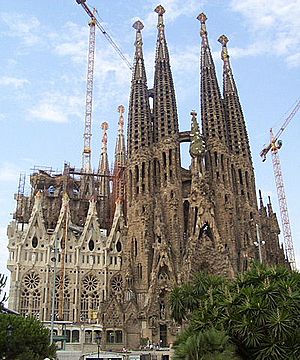
- The Church of the Holy Sepulchre, Jerusalem, Israel
- The Basilica of St. Nicholas of Bari in Bari, Italy
- The Basilica of St. Anthony of Padua in Padua, Italy
- The Basilica of St. Francis of Assisi in Italy
- The Basilica of St. Mark in Venice, Italy
- The Basilica of St. Denis, near Paris, France
- The Basilica of St. Louis, St. Louis, Missouri USA
- The Basilica of Our Lady of Fátima, Portugal
- The Cathedral Basilica of San Thome, Chennai, India
- St. Stephen's Basilica, Budapest, Hungary
- The Cathedral Basilica of St. Chad, Birmingham England (1941)
- The Cathedral Basilica Shrine of Our Lady of the Rosary, Argentina
- The Cathedral Basilica of St. Mary, Help of Christians Sydney, Australia
- The Basilica of Our Lady of Peace of Yamoussoukro, in Côte d'Ivoire West Africa
- The Cathedral Basilica of Notre-Dame de Québec in Quebec City was the first basilica in North America. (1874)
- The Cathedral Basilica of Our Lord Jesus Christ King of the Universe, Reykjavík, Iceland
- The Basilica of St. Adalbert in Buffalo, New York was the first Basilica in the United States of America, (1907)
- The Cathedral Basilica of Las Lajas, in Colombia
- Berchem Basilica, Antwerp, Belgium (1878)
- San Francisco de la Habana Basilica in Havana, Cuba
- The Basilica of St. Gereon, Cologne, Germany (1920)
- The Basilica of Our Lady of Lanka, Tewatte, Sri Lanka
- The Basilica of the Black Nazarene, Philippines
- The Basilica of Emmaus Nicopolis, Israel
- The Basilica of la Sagrada Familia, Spain, has been under construction since 1882. It is still unfinished. But Pope Benedict XVI made it a minor basilica in November 2010.
Images for kids
-
The Church of the Holy Sepulchre is an "Ancient Basilica" in Jerusalem.
-
The Basilica of the Holy Child, Philippines
-
The Basilica of St. Charles Borromeo is an historic mission church in California.
-
The Basilica Bom Jesus, Goa, India, contains the Tomb of St. Francis Xavier.
-
The Basilica of St. Mary, Help of Christians is the first Catholic Cathedral in Australia.
-
The Basilica of St. Mary, Gdansk, Poland, has been restored after bad damage in World War II.
-
The Basilica of Our Lady of the Angels in Costa Rica.
-
The Cathedral Basilica of St Vitus in Prague is built inside the castle walls.
-
The Basilica of Our Lady of Glory in Brazil was completed in 1972.
-
The Basilica of Ste Anne de Beaupré, Québec, Canada is famous for healing miracles.
-
Mariazell Basilica in Austria has a famous statue called the "Great Mother Mary of Austria".
-
The Basilica of Our Lady of Bruges, Belgium has a statue of the Madonna by Michelangelo.
-
The Basilica of Bonn Germany was built where two Christian Roman soldiers were killed for their faith.
-
The modern Basilica of Our Lady of Guadalupe in Mexico City has the famous image of Mary, Patron of the Americas.
-
The Cathedral Basilica of Braga, Portugal.
-
The Basilica of La Madeleine Vezelay, France, has a relic of Mary Magdalene.
-
Basilica in Salta.
-
Digital reconstruction of the 2nd century BC Basilica Sempronia, in the Forum Romanum.
-
Remains of the 2nd century BC Basilica Aemilia by Giuliano da Sangallo in the 15th century AD.
-
Ruins of the Trajanic basilica at Baelo Claudia.
-
Bust of Augustus from the basilica-stoa of Ephesus, defaced with a Christian cross.
-
The 4th-century Basilica of Constantine at Trier was a palatine basilica. It was used for receiving Constantine's political clients. The apse windows are smaller than the side windows. This creates an optical illusion of greater size and distance.
-
Aula Palatina, Constantine's basilica at Trier, around 310 AD.
-
St Peter's Basilica, Vatican City. It is a major basilica of the Catholic Church. It is a central-plan building, enlarged by a basilical nave.
-
Interior of Santa Sabina, with Corinthian columns from the Temple of Juno Regina.
-
5th-century mosaic of a basilica (Louvre).
-
Hall church: All arches are almost at the same level.
-
Aisleless church with wallside pilasters, a barrel-vault and upper windows above side chapels.
-
Old St Peter's, Rome. This shows how the 4th-century basilica looked by the mid-15th century. This is a 19th-century reconstruction.
-
Romanesque basilica of nowadays Lutheran Bursfelde Abbey in Germany.
-
Chester Cathedral in England, a Gothic style basilica.
-
St. Sebald's in Nuremberg has a basilical nave and a hall choir.
-
Palma Cathedral on Mallorca in Spain has windows on three levels. One above the aisles, one above the chapels, and one in the chapels.
-
A rare American church built like an Early Christian basilica. St. Mary's (German) Church in Pennsylvania, now torn down.
Related Pages
See also
 In Spanish: Basílica para niños
In Spanish: Basílica para niños


